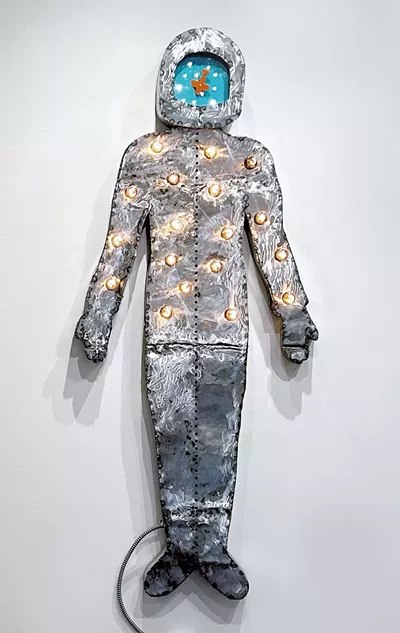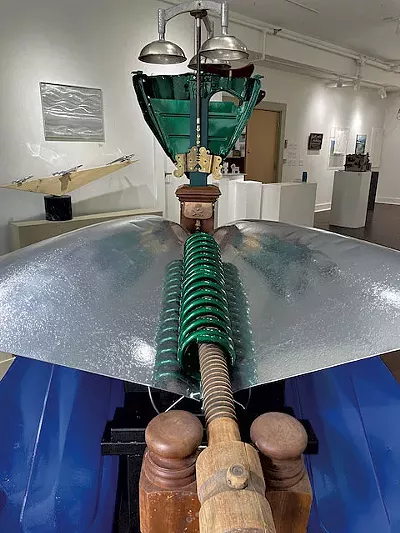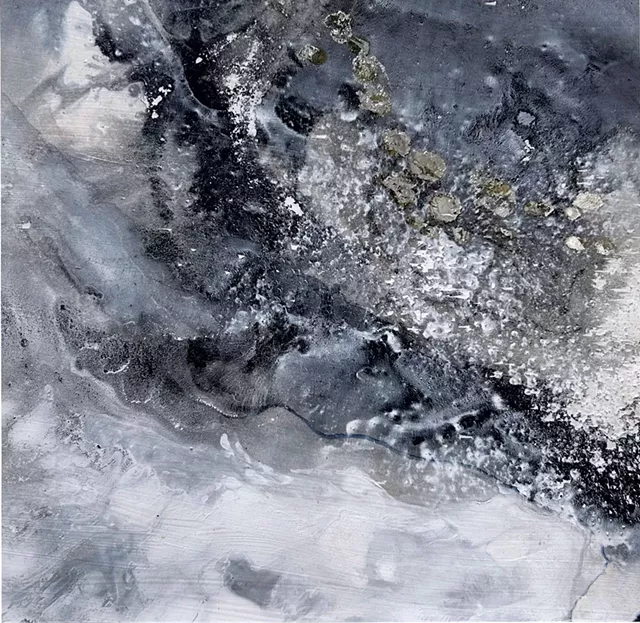By long tradition, each anniversary gets its own material: The first is paper; the fifth, wood; 25 years means silver. While the symbolism isn’t always clear, that last one seems dead-on: Underneath the glitz and glam, sparkling silver requires a lot of elbow grease.
That is definitely the case for Studio Place Arts in Barre, which celebrates a quarter-century this year with the exhibition “Silver Lining,” on view through April 19. Thirty-five artists have contributed shiny objects, ranging from intricate jewelry to massive sculptures to paintings with just a bit of bling.
The exhibition isn’t the retrospective one might expect. Five years ago, executive director Sue Higby put together a third-floor show highlighting important works and moments from the organization’s first 20 years, which kicked off a fundraising campaign to build an endowment. The excitement and momentum of the moment, however, was quickly squashed by the COVID-19 shutdown.
“There was no celebratory feeling in the air,” Higby said.
After the slog of a drawn-out pandemic, the building was hit by three floods in one year — in July and December 2023 and July again in 2024. When Higby, 64, wasn’t mucking out the basement herself, she was raising the necessary funds to literally build a new foundation for the art center, one section of triple-layered masonry at a time.
Early in the 19th-century building’s history, it was home to a jewelry store, an art supply shop, a grocery store, a restaurant, a bike shop, a pool hall, a shooting gallery, an auction house and possibly Vermont’s first motorcycle dealer. The second floor housed boarders, and large spaces on the third floor hosted labor union meetings, temperance activists and even Swedish church services. By the late 1990s, however, it was in sad shape, scarred by arson and sitting derelict.
Rather than flatten it for a parking lot, the city council opted for a long-shot proposal from the Barre Historical Society to offer it to six artists who would fix it up as studios and start an art center, revitalizing downtown in the process. It was easier said than done: One of SPA’s founding artists, Janet Van Fleet, said via email that when they took over the building, “the back wall of my studio was open to the elements and there were pigeons flying in and out.”
Higby, then a volunteer board member, stepped in to lead the organization in 2003 after renovations, floods and administrative missteps had left it in a precarious position. As Georgia Landau, another of SPA’s founding artists, described it: “Sue saved us, at maybe the last minute.”
Drawing on her extensive nonprofit experience, Higby did so by prioritizing artists and building individual relationships with donors, even those lacking deep pockets, she said. SPA’s $35 annual membership rate — $20 for seniors and students — has stayed the same since it opened. The org does not receive funding from federal, state or municipal grants. Her revenue approach is “mostly about inclusion,” Higby said. “We want people to feel very comfortable being involved at the level that they’re able to.”
“Silver Lining” is perhaps the best illustration of that principle. The exhibition is fun and forward-looking, showcasing a broad range of styles from artists as far away as Maine and as close as the studios upstairs.
Sculptor Matt Neckers has gone all in, contributing a slew of sculptures with his signature tinfoil-robot aesthetic. “Astronaut” seems to hover on one wall, filament light bulbs illuminating its steel torso like a vintage motel sign. Nearby, “Satellite” is a mysterious dish constructed of welded steel and wood scraps, surely receiving transmissions from outer space.
Those sculptures set a sci-fi vibe for the show, not only celebrating SPA’s past but pointing toward an elegant, playful future. Christopher Curtis‘ 44-inch-high “Like Minds” features a pair of elongated, curving stainless forms on a black granite base. They look like space-age wind turbines locked in an unexpectedly tender gesture.
Adam Wager‘s “Projections I” offers the viewer the moon, painted in silver leaf on the inside of a small turned-walnut cup. A visitor can bend down and, shutting one eye, just glimpse the moon as it comes into view through a small square hole in the cup’s side. It’s an exquisite little piece that cleverly re-creates the experience of fleeting moonlight.
Scale tips the other way with Roger Weingarten‘s “Man Moth, Icarus, Minotaur,” a 7-by-5-foot sculpture that’s like a Victorian member of the Transformers franchise. With silvery wings and some steel components powder-coated in jewel-tone blue, green and copper, the insect-inspired sculpture includes antique car fenders, a carved wooden newel post, vintage brass icebox hinges, an old washing machine agitator and a giant green spring.
Others interpret the theme via the natural world. Emily Piccirillo‘s painting “Below Zero” silhouettes silver branches against a white winter sky. The square of canvas is stretched on a metal frame that projects out a few inches from the wall, pulled by taut threads. The effect enhances the image, reminding the viewer of the feel of a thin winter sky and brittle, frozen branches.
Elizabeth Nelson‘s 8-by-8-inch “Corner of My Eye” is another winter view, but from space; white sweeps over inky blue, with an archipelago of silver leaf splotches. Looking at it is not unlike peering out an airplane window and seeing flashes of light reflecting off the Earth’s surface.
Several jewelry artists concentrate their sparkles. Cari Clement‘s “Ice Ice Baby Necklace & Earrings” pairs glass beads with chunks of rock for jewelry reminiscent of melting snow and ice. Kristine Chartrand‘s and Kerin Rose‘s sterling silver necklaces present wearable surrealist imagery, such as the large bird hanging from a collar of silver twigs in Rose’s “I dreamt of Frida…”
Leslie Fry brings similar imagery to “Nesting,” a silver-patinaed bronze sculpture of a harpy. Here, a woman’s face sits atop a bird body, its wings made of folded hands; its nest is a pile of tools. It’s one of a handful of pieces that seems like a reference to what SPA and its artists have accomplished in this building.
Two more literal works in that vein are Elizabeth Fram‘s “Spirit of SPA,” a watercolor portrait of Van Fleet, and next to it that artist’s own contribution to the show. It’s a little coffee pot with legs, pouring a string of silver buttons. That imagery, combined with its title — “Our cup runneth over: 25 Years of Service” — echoes what Higby said it’s taken to make this place sparkle: “love and grit.”



